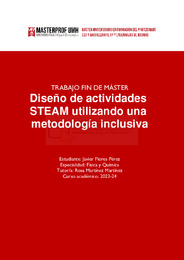Please use this identifier to cite or link to this item:
https://hdl.handle.net/11000/32916Full metadata record
| DC Field | Value | Language |
|---|---|---|
| dc.contributor.advisor | Martínez Martínez, Rosa | - |
| dc.contributor.author | Flores Pérez, Javier | - |
| dc.date.accessioned | 2024-09-04T10:46:16Z | - |
| dc.date.available | 2024-09-04T10:46:16Z | - |
| dc.date.created | 2024-06 | - |
| dc.identifier.uri | https://hdl.handle.net/11000/32916 | - |
| dc.description | Especialidad: Física y Química | es_ES |
| dc.description.abstract | La educación STEAM (Science, Technology, Engineering, Arts and Mathematics) se presenta como una herramienta fundamental para afrontar los retos del siglo XXI como pueden ser la creatividad, la resolución de problemas o la comunición efectiva. El DUA (Diseño Universal del Aprendizaje) destaca como un marco educativo crucial para hacer que la educación STEAM sea más inclusiva, basándose en la idea de que todos los estudiantes aprenden de manera diferente y que las experiencias de aprendizaje deben ser accesibles para todos. En este trabajo se ha realizado una revisión bibliográfica proporcionando evidencia que apoya la efectividad de combinar STEAM y DUA para mejorar el aprendizaje de los estudiantes y también se propone tres propuestas de actividades para llevar a cabo en el aula relacionadas con la tabla periódica, donde también se utiliza la gamificación como una estrategia para hacer de las actividades más atractivas y motivadoras para el estudiantado, utilizando elementos de juego para crear experiencias de aprendizaje dinámicas e interactivas | es_ES |
| dc.description.abstract | STEAM education (Science, Technology, Engineering, Arts and Mathematics) is presented as an essential tool to face the challenges of the 21st century, such as creativity, problem solving and effective communication. The UDL (Universal Design for Learning) stands out as a crucial educational framework to make STEAM education more inclusive, based on the idea that all students learn differently and that learning experiences should be accessible to everybody. In this paper we have conducted a literature review providing evidence supporting the effectiveness of combining STEAM and UDL to improve students' learning and also proposes three activities to be carried out in the classroom related to the periodic table, where gamification is also used as a strategy to make the activities more attractive motivating for the students, using game elements to create dynamic and interactive learning experiences | es_ES |
| dc.format | application/pdf | es_ES |
| dc.format.extent | 24 | es_ES |
| dc.language.iso | spa | es_ES |
| dc.publisher | Universidad Miguel Hernández | es_ES |
| dc.rights | info:eu-repo/semantics/openAccess | es_ES |
| dc.rights.uri | http://creativecommons.org/licenses/by-nc-nd/4.0/ | * |
| dc.subject | Diseño Universal para el Aprendizaje | es_ES |
| dc.subject | STEAM | es_ES |
| dc.subject | Gamificación | es_ES |
| dc.subject | Tabla periódica | es_ES |
| dc.subject.other | CDU::3 - Ciencias sociales::37 - Educación. Enseñanza. Formación. Tiempo libre | es_ES |
| dc.title | Diseño de actividades STEAM utilizando una metodología inclusiva | es_ES |
| dc.type | info:eu-repo/semantics/masterThesis | es_ES |

View/Open:
TFM Flores Pérez, Javier.pdf
442,92 kB
Adobe PDF
Share:
.png)
